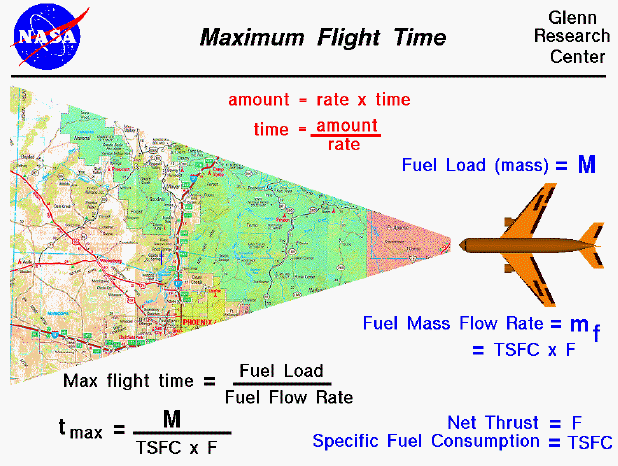

Maximum Flight Time
Activity
If so instructed by your teacher, print out a workskheet page for these problems.

Complete the following activities that relate to the Maximum Flight Time of an aircraft. You may want to read additional slides from the Beginner's Guide to Propulsion. It will be helpful to use the links on the Maximum Flight Time slide.
- The Maximum Flight
Time for an aircraft depends on the specific fuel consumption,
net thrust, and the mass of the fuel load. If all
other factors for the following aircrafts remain the same, which of
the 2 aircraft has the longer maximum flight time? Place an "X"
on the correct line.
A.AIRCRAFT A - The throttle setting is 58% ___________
AIRCRAFT B - The throttle setting is 75% ___________
B.AIRCRAFT A - The engine is producing 1500 pounds of thrust _______
AIRCRAFT B - The engine is producing 2000 pounds of thrust ________
C.AIRCRAFT A - has a turbojet engine with an afterburner ________
AIRCRAFT B - has a plain turbojet engine __________
D.AIRCRAFT A - has a turboprop engine ____________
AIRCRAFT B - has a rocket engine ___________
E.AIRCRAFT A - has a L/D (lift to drag ratio) of .5 __________
AIRCRAFT B - has a L/D (lift to drag ratio) of .8 __________
F.AIRCRAFT A - has a fuel mass flow rate of 2500 lbm/hr_________
AIRCRAFT B - has a fuel mass flow rate of 3500 lbm/hr__________
Before you complete Step 2, make sure you are comfortable with the Maximum Flight Time Equation as well as the Range Equation.
- For a given mission,
the required flight time could replace the maximum flight time in the
required equation. This idea may be needed to solve the following:
A. For mission I, we need 4500 pounds of thrust for 3 hours. If the Thrust Specific Fuel Consumption is .8, how much fuel is needed for this mission?
B. For the second mission, the engines are being fed from a fuel tank that delivers 3200 pounds mass per hour. If the aircraft is producing 2500 pounds of thrust, what is the TSFC?
C. If the aircraft can carry 20,000 pounds mass of fuel plus the amount needed for takeoff and landing, what is the limit for the time the mission can take?
D. The aircraft plans to maintain a cruise speed of 120 mph. What is the aircraft's maximum range?
E. The aircraft was forced to land unexpectedly. At that time, there were only 15,000 pounds mass of fuel in excess of that needed for takeoff and landing. All other conditions remain the same. If the final destination of the mission is 630 miles away, what cruise speed should be maintained?
EDUCATOR RESOURCES | AERONAUTIC EDUCATIONAL RESOURCES | INTERNET ACCESS RESEARCH | ICING RESEARCH TUNNEL
BEGINNER'S GUIDE TO AERONAUTICS | FREE SOFTWARE | AERODYNAMICS INFORMATION | AERODYNAMICS PROBLEMS | PROPULSION INFORMATION |
PROPULSION PROBLEMS | FOILSIM INFORMATION | FOILSIM PROBLEMS | ENGINESIM INFORMATION | ENGINESIM PROBLEMS | ROCKETMODELER
AERONAUTICS LESSONS & ACTIVITIES | WIND TUNNEL WEB PAGES | AERONAUTS 2000 | VIDEOCONFERENCES WITH THE U.K.
Curator: Tom.Benson@grc.nasa.gov
Responsible Official: Kathy.Zona@grc.nasa.gov